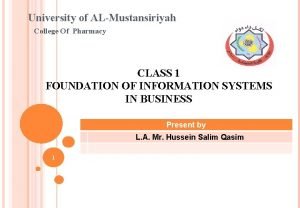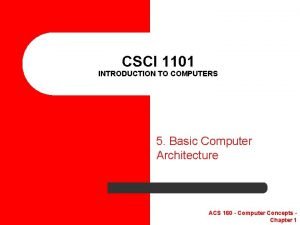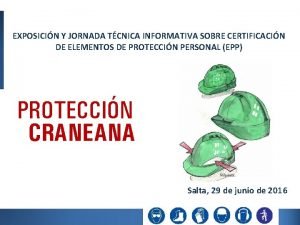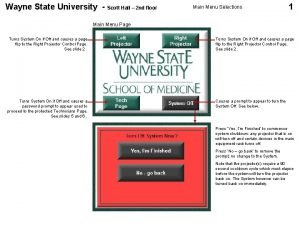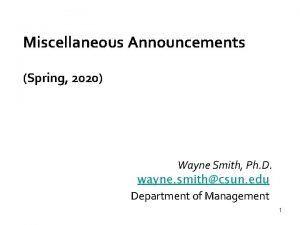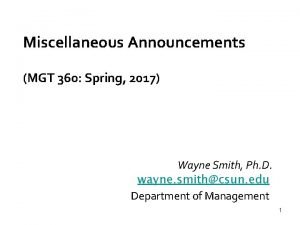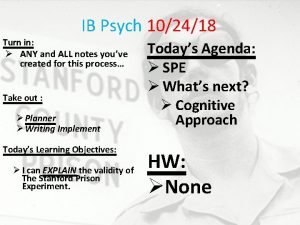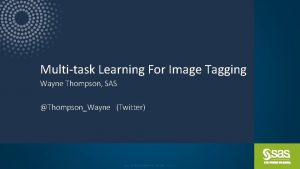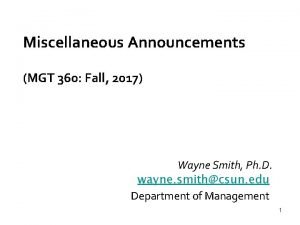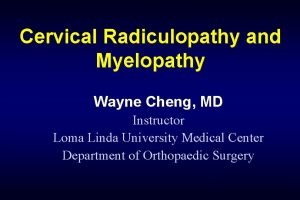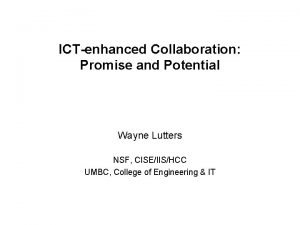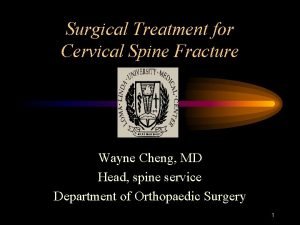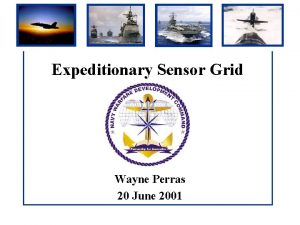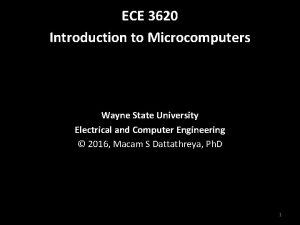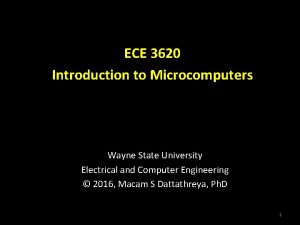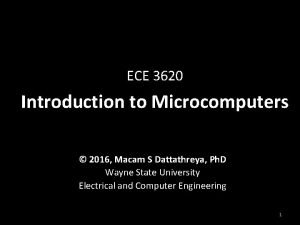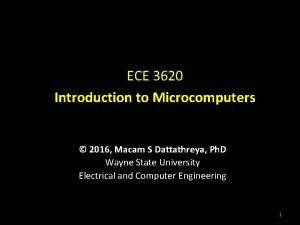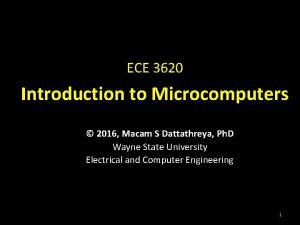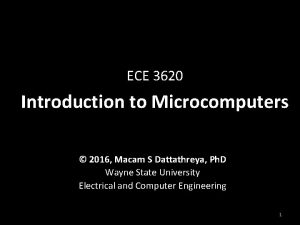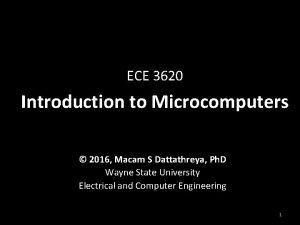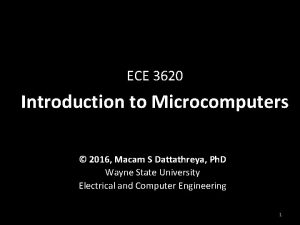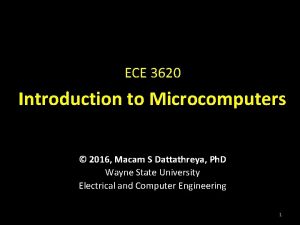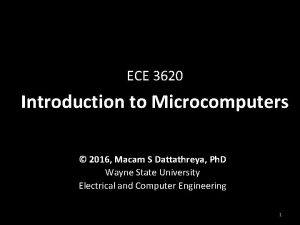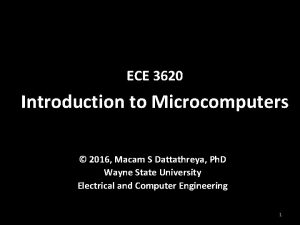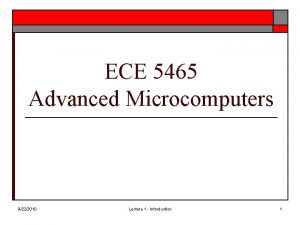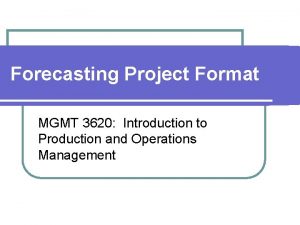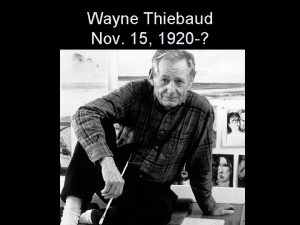ECE 3620 Introduction to Microcomputers Wayne State University

















































- Slides: 49

ECE 3620 Introduction to Microcomputers Wayne State University Electrical and Computer Engineering © 2016, Macam S Dattathreya, Ph. D 1

Course Topics Unit Topic Duration (weeks) 1 Microcomputer Execution of Assembly Programs: A Brief Overview 1 2 Instructions, Addressing Modes, Data Representation, Arithmetic and Logic, Branching, and Simple Assembly Programs 2 3 68 HC 11 Assembly Programming and Development Tools 2 4 Stacks, Subroutines and Data Structures 1 5 The Hardware Configuration and Interrupts 1 6 Parallel I/O – Ports B and C 1 7 The Analog-to-Digital Converter – Port E 1 8 The Timing System and Port A 2 © 2016, Macam, Introduction to Microcomputers 2

Unit#7 Table of Contents • • • Port E A/D converter pins (EVBPlus 2 board) A/D converter resolution Configure the A/D system A/D conversion using the 68 HC 11 © 2016, Macam, Introduction to Microcomputers 3

Port -E Input pins only. No data Direction registers required Input Port 8 input pins Upper and lower voltages © 2016, Macam, Introduction to Microcomputers 4

A/D Conversions: Basics Resolution = range/28 = range/256 (this is the voltage represented by each digital increment) Positive Analog Input 68 HC 11 A/D Converter VRH ADRX 8 -Bit Digital Register Reference Voltage Range PE 0 VRL 0 1 1 0 0 1 Converting Analog to Digital number Input Voltage Range = VRH - VRL © 2016, Macam, Introduction to Microcomputers 5

A/D Conversions: Basics • Reference voltage restrictions – VRH <= VDD (+5 V) – VRL >= ground (i. e. , 0 V) – VRH – VRL > 2. 5 V • Users can set the reference voltages – Range of voltages for digital conversion • If VRH and VRL are close – Converts small range of voltages – Resolution will be higher – EVBPlus 2 configuration: VRH = 5 V and VRL = 0 V © 2016, Macam, Introduction to Microcomputers 6

A/D Converter Input pins only. No data Direction registers required 1. Power Up 2. Writes configurationcontrol byte to A/D Control (ADCTL) & after one clock cycle is elapsed 3. A/D conversion starts 8 A/D conversion channels attached Can be configured to perform conversion sequences (modes): a. Single-channel b. Multiple-channel © 2016, Macam, Introduction to Microcomputers 7

A/D Example#1 • If VRH is 4 V and VRL is 1 V, what is the range and resolution of the A/D converter? • Solution – Range = VRH – VRL = 4 -1 = 3 V – Resolution = range/256 = 3/256 = 11. 72 m. V – Each digital increments = 11. 72 m. V © 2016, Macam, Introduction to Microcomputers 8

A/D Example#2 • An analog input it applied to the A/D converter of the previous example and the digital register reads $49. What is the analog voltage? • Solution – Hex $49 = 7310 • 73 increments of 11. 72 m. V = 0. 85556 V • Add this to VRL or 1 V (to get correct analog voltage) 1. 856 V © 2016, Macam, Introduction to Microcomputers 9

A/D Example#3 • An analog input it applied to the A/D converter of the previous example and the digital register reads $49. What is the analog voltage assuming the A/D on the EVBplus 2 is used? • Solution – Range = VRH – VRL = 5 - 0 = 5 V – Resolution = 5/256 = 19. 53 m. V – Hex $49 = 7310 = 73 increments – Applied Voltage = (73 * 19. 53) + VRL = 1. 426 V © 2016, Macam, Introduction to Microcomputers 10

Port E Pins on the EVBplus 2 PE 0 – PE 7 can be connected to external devices through EVBPlus 2 Pins 43 -50 Port E Pins PE 4 – PE 7 Port E Pins PE 0 – PE 3 0 V (Ground) 5 V PE 0 – PE 3: Available for Sensor port connection (@ bottom of the EVBPlus 2) © 2016, Macam, Introduction to Microcomputers 11

Port E Pins on the EVBplus 2 PE 0 – PE 3: Available for Sensor port connection Provides power supply and ground for the sensor (Required for active PE 0 – PE 3: pulled up by 100 K Ohms resistor each sensors e. g. , sonar or infra-red) Voltage at these pins: 5 V if no signal is connected. © 2016, Macam, Introduction to Microcomputers 12

Port E Pins on the EVBplus 2 PE 7 is connected to the on-board trimmer (Potentiometer (variable resistor)) Employs a voltage divider Circuit (see how it is connected to 68 HC 11) Dial rotations changes the voltage @ PE 7 continuously in the range: 0 – 5 Volts © 2016, Macam, Introduction to Microcomputers 13

A/D Example#4 • A KΩ resistor is connected between pin PE 1 of the 68 HC 11 (on the EVBplus 2) and ground as shown in the figure below? • Draw a circuit to solve for the voltage across the resistor. This voltage is a also the analog value applied at PE 1. What is the digital byte generated by the A/D converter upon converting this voltage? © 2016, Macam, Introduction to Microcomputers 14

• Solution: A/D Example#4 – The 10 K resistor is connected to PE 1 (sensor port) – Since, PE 1 is pulled up by a 100 K resistor, the hardware connections are as follows © 2016, Macam, Introduction to Microcomputers 15

• Solution: A/D Example#4 – This circuit can solve for the voltage across 10 K resistor, RL – 5 V applied across two resistors in series – To solve, use voltage division formula (RL in K Ω): • VPE 1 = (RL *5)/(RL + 100) = (10 * 5)/(10 + 100) = 0. 455 V © 2016, Macam, Introduction to Microcomputers 16

A/D Example#4 • Solution: – From the previous example: A/D resolution on EVBPlus 2: 19. 53 m. V • Converted digital byte (decimal) = 0. 455/0. 01953 = 23 (rounding) • The generated byte: 00010111 – During experiments, the actual value may be slightly different than theoretical values • Due to resistor tolerance i. e. , variability in resistance value © 2016, Macam, Introduction to Microcomputers 17

A/D Converter Registers • Seven registers used in the A/D conversion – OPTION – A/D Control (ADCTL) – PORTE Data – Four A/D Result (ADR 1 – ADR 4) © 2016, Macam, Introduction to Microcomputers 18

68 HC 11 OPTION Register Voltage levels on the Port E pins are converted to their digital equivalents After APDU is set, a small delay of at least 100 µs is needed to allow internal A/D circuitry to stabilize before conversion process A/D converter is enabled if this bit = 1 (set) (A/D Power Up) Used to enable/disable A/D conversion process (8 bits) When ADPU is 1 and A/D converter is activated, the four data registers ADR 1 – ADR 4 (@ $1031 $1034) holds the converted digital data (discuss more later) © 2016, Macam, Introduction to Microcomputers 19

68 HC 11 OPTION Register When ADPU is 0 and A/D converter is deactivated, Port E functions as a general purpose parallel input register A/D converter is disabled if this bit = 0 (un set) (Upon RESET) Used to enable/disable A/D conversion process When ADPU is 0 and A/D converter is deactivated, the inputs from the pins PE 0 -PE 7 are saved in the PORTE register at $100 A (default configuration of Port E) © 2016, Macam, Introduction to Microcomputers 20

OPTION Register Example Program • A program segment to turn on and stabilize the A/D system • Solution: © 2016, Macam, Introduction to Microcomputers 21

A/D Control Register (ADCTL) Read only (0 upon RESET) A to D starts one clock cycle after ADCTL is written (32 clock cycles/one sample conversion) This bit is set when ADR 1 to ADR 4 contain valid conversion data (i. e. , 129 clock cycles (64 µs) after the ADCTL is written) Writing a configuration byte into this register initiates A/D conversion This bit is cleared automatically and a conversion sequence is started © 2016, Macam, Introduction to Microcomputers 22

A/D Control Register (ADCTL) If this bit is 1 (scan mode) • Each channel is scanned and conversions continue • Newer results overwrite older results • CCF bit is ignored If this bit is 0 (non-scan mode) • Four conversions are performed • Four ADR registers filled in with data • When CCF is set, conversion terminates © 2016, Macam, Introduction to Microcomputers 23

A/D Control Register (ADCTL) If this bit is 1 (multi channel mode) • One conversion on each channel in a four-channel group (either PE 0 -PE 3 or PE 4 -PE 7) • Four conversions fill the ADR registers If this bit is 0 (single channel mode) • Four successive conversions are performed on a single channel (e. g. , PE 0) • Four results written into ADR 1 -ADR 4 registers • Unless the analog voltage changes rapidly, four registers will have the same value © 2016, Macam, Introduction to Microcomputers 24

A/D Control Register (ADCTL) Used to determine which channels are being converted © 2016, Macam, Introduction to Microcomputers 25

A/D Control Register (ADCTL) If MULT = 0, these bits determine the channel to be converted E. g. , if the bits are 0011 Voltage at PE 3 is converted and four consecutive samples of the voltage are saved at ADR 1 – ADR 4 © 2016, Macam, Introduction to Microcomputers 26

A/D Control Register (ADCTL) If MULT = 1, only CD and CC are relevant CD = 0 & CC = 0 : Samples the first group of lines PE 0 -PE 3 (Results are stored at ADR 1 -ADR 4, respectively) CD = 0 & CC = 1 : Samples the second group of lines PE 4 -PE 7 (Results are stored at ADR 1 -ADR 4, respectively) © 2016, Macam, Introduction to Microcomputers 27

ADCTL Register Example Program • A program segment to set up the ADCTL for a single conversion on channel 0 (connected to PE 0) Sets SCAN and MULT = 0; • Solution: Channel assignment = 0000 (channel 0) Loops until ADCTL’s MSB is set to 1 (indicates that the conversions are available in ADRs) Sets CCF = 0; A/D conversion is triggered © 2016, Macam, Introduction to Microcomputers 28

ADCTL Register Example Program • A program segment to set up ADCTL for continuous sampling of the channels PE 4 -PE 7. Where does the Replace this with conversion for PE 5 go? #%00110100 (2 LSBs are not significant) • Solution: The latest conversion for channel 5 can be read from ADR 2 @ $1032 © 2016, Macam, Introduction to Microcomputers 29

ADCTL Register Example Program • If $11 is written into the ADCTL, what will happen? Where will the digital conversion of PE 3 go? • Solution: – ADCTL = %0001 – SCAN bit =0 & MUL bit = 1 (configuration for multiplechannel, single-conversion mode) – The channel assignment bits CD = 0 and CC = 0 (indicates that the first group of channels (PE 0 – PE 3) is selected) – Generates one conversion for each of the channels PE 0 – PE 3 – Results saved in ADR 1 – ADR 4, respectively – The digital conversion of the line PE 3 is in ADR 4 register at $1034 © 2016, Macam, Introduction to Microcomputers 30

ADCTL Register Programing Example 1 • A program segment to set up the ADCTL for a single conversion on channel 5 (connected to PE 5). Send the converted result to PORTB. Make sure you include code to activate the A/D converter • Solution: © 2016, Macam, Introduction to Microcomputers 31

ADCTL Register Programing Example 1 Solution • Generates four samples of the input voltage at PE 5 • Saves them in ADR 1 – ADR 4 • If the data does not change fast, all these values will be very close to each other • This program, made a choice to read data from ADR 1 • Any of the other ADR registers can be selected • Many programs would simply take the average of these results as the correct response © 2016, Macam, Introduction to Microcomputers 32

A/D Result Registers: ADR 1 – ADR 4 8 -bit registers, hold the A to D conversion results Valid only when CCF flag bit on ADCTL = 1 © 2016, Macam, Introduction to Microcomputers 33

A/D Conversion: Single Channel (non-Scan) OPTION Register (set Red, Unset white) ADPU CSEL Converter upover & CCF cleared CCF set, powered conversion ADCTL Register (set Red, Unset white) CCF SCAN MULT Non-scan mode CD CC Selected A/D conversion channel (conversion in 4 samples) CA – CD unset = PE 0 Single channel CB CA ADR 1 (for sample 1) 0 1 1 0 0 1 ADR 2 (for sample 2) Analog input PE 0 Sample 4 Sample 2 Sample 1 Sample 3 A/D converter 0 1 1 0 0 1 ADR 3 (for sample 3) 0 1 1 0 0 1 ADR 4 (for sample 4) 0 1 1 0 0 1 © 2016, Macam, Introduction to Microcomputers 34

A/D Conversion: Single Channel (non-Scan) • Single-channel mode (on selected channel): – Can be configured to perform conversion sequences four times – Non-scan and scan-modes • Non-scan: Four consecutive samples from the single selected channel and converted • First result stored in ADR 1, second in ADR 2, etc. • After fourth conversion is completed, conversion halts • Conversion command written to ADCTL © 2016, Macam, Introduction to Microcomputers 35

A/D Conversion: Single Channel (Scan) OPTION Register (set Red, Unset orange) ADPU CSEL Converter powered over up & CCF cleared CCF set, conversion Scan mode ADCTL Register (set Red, Unset green) CCF SCAN MULT CD CC CA – CD unset = PE 0 Single channel CB CA ADR 1 (for sample 1) Selected A/D conversion channel (continuous) 0 1 1 0 0 1 ADR 2 (for sample 2) Analog input PE 0 A/D converter 0 1 1 0 0 1 ADR 3 (for sample 3) 0 1 1 0 0 1 ADR 4 (for sample 4) 0 1 1 0 0 1 © 2016, Macam, Introduction to Microcomputers 36

A/D Conversion: Single Channel (Scan) • Scan-mode: – Conversions are performed continually on the selected channel • First result stored in ADR 1, second in ADR 2, etc. • After fourth conversion is completed, conversion halts • Conversion command written to ADCTL © 2016, Macam, Introduction to Microcomputers 37

A/D Conversion: Multi Channel (non-Scan) OPTION Register (set Red, Unset orange) ADPU CSEL Converter upover & CCF cleared CCF set, powered conversion ADCTL Register (set Red, Unset green) CCF MULT SCAN Non-scan mode MULT CD CC Selected A/D conversion channel group (conversion in 4 channels) Analog inputs (for 4 channels) A/D converter PE 4 PE 7 PE 5 PE 6 PE 7 channel PE 4 CD unset and CC set = PE 4 PE 7 group Multi channel CB CA ADR 1 (for sample 1) 0 1 1 0 0 1 ADR 2 (for sample 2) 0 1 1 0 0 1 ADR 3 (for sample 3) 0 1 1 0 0 1 ADR 4 (for sample 4) 0 1 1 0 0 1 © 2016, Macam, Introduction to Microcomputers 38

A/D Conversion: Multi Channel (non-Scan) • Multiple-channel mode: – Configured to perform one time on each of four channels • • Either PE 0 – PE 4 or PE 4 -PE 7 channels First result is stored in register ADR 1 The second result is stored in register ADR 2, and so on After the fourth conversion, all conversion activity is halted – Until a new conversion command is written into the ADCTL © 2016, Macam, Introduction to Microcomputers 39

A/D Conversion: Multi Channel (Scan) OPTION Register (set Red, Unset green) ADPU CSEL Converter powered over up & CCF cleared CCF set, conversion Scan mode ADCTL Register (set Red, Unset green) CCF MULT SCAN MULT CD CC CD unset and CC set = PE 4 PE 7 group Multi channel CB CA ADR 1 (for sample 1) Selected A/D conversion channel group (continuous) 0 1 1 0 0 1 ADR 2 (for sample 2) Analog inputs for 4 channels PE 4 – PE 7 A/D converter 0 1 1 0 0 1 ADR 3 (for sample 3) 0 1 1 0 0 1 Converts all 4 channels continuously and 5 th conversion result starts storing in ADR 1, 6 th in ADR 2, and so son ADR 4 (for sample 4) 0 1 1 0 0 1 © 2016, Macam, Introduction to Microcomputers 40

A/D Conversion: Multi Channel (Scan) • Multiple-channel mode: – Configured to perform one time on each of four channels • Either PE 0 – PE 4 or PE 4 -PE 7 channels • Conversions are performed continually on the selected group of four channels (4 times) • Fifth conversion is stored in register ADR 1 (replacing the earlier conversion result for the first channel in the group) • the sixth conversion overwriting ADR 2, and so on © 2016, Macam, Introduction to Microcomputers 41

Procedure for Using A/D System • Step 1: – Connect the hardware properly – Input analog voltage range between VRH - VRL – Else, must scale the input signal and bias it to the proper range. If EVBplus 2: range = 0 to 5 V • Step 2: – Set the ADPU bit of the OPTION register to enable the A/D system © 2016, Macam, Introduction to Microcomputers 42

Procedure for Using A/D System • Step 3: – Wait for the A/D system to stabilize – The user can use a program loop to create a delay of at least 100 ms • Step 4: – Select the appropriate channel(s) and operation modes by programming the ADCTL register © 2016, Macam, Introduction to Microcomputers 43

Procedure for Using A/D System • Step 5: – Non-scan mode: • Wait until the CCF bit (ADCTL) is set • Then collect the A/D conversion results and use them in your program • When CCF bit is 1, the ADCTL value becomes negative, user to decide if the conversion is completed • While CCF = 1, no further conversions are performed • When CCF = 0, A new conversion is automatically performed – Scan-Mode: • Conversions are continuous, no waiting for CCF bit set © 2016, Macam, Introduction to Microcomputers 44

ADCTL Register Programing Example 2 • Write a program to set up the ADCTL for continuous conversion of channels PE 0 -PE 3. Run the program on the THRSim 11. Employ the “Slider E port” tool to provides the following input voltages: 625 m. V on PE 0, 1. 25 V on PE 1, 2. 5 V on PE 2 and 5 V on PE 3. Run the program and verify the contents of the ADCTL register ($1030) and the ADR 1 – ADR 4 registers ($1031 - $1034). • Solution: © 2016, Macam, Introduction to Microcomputers 45

ADCTL Register Programing Example 1 Solution • Same as the Example program 1 • Difference: the configuration byte • Continuous conversion of multiple channels PE 0 -PE 3. • Does not write into PORTB © 2016, Macam, Introduction to Microcomputers 46

THRSim 11: Sliders E Port View Sliders E port (from the main menu) Required slider settings Each slider is connected to one of the Port E lines (PE 0 to PE 4) (provides 0 & 5000 m. V increments) © 2016, Macam, Introduction to Microcomputers 47

THRSim 11: Memory List After running the program, the memory list (ADCTL, and ADR 1 – ADR 4) CCF is set = 25510, reflects the digital conversion on PE 3 © 2016, Macam, Introduction to Microcomputers 48

THRSim 11: Memory List Simulator VRH = 5 V and VRL = 0 V, resolution = 5/256 = 19. 53 m. V PE 0 = 6. 25 m. V ADR 1 = $20 = 32 * 19. 53 = 6. 25 m. V (Correct PE 0 analog voltage) PE 1 = 1. 25 V ADR 2 = $40 = 64 * 19. 53 = 1. 249 V (Very close to PE 1 analog voltage) PE 2 = 2. 5 V ADR 2 = $80 = 128 * 19. 53 = 2. 499 V (Very close to PE 2 analog voltage) PE 3 = 5 V ADR 3 = $FF = 255 * 19. 53 = 4. 98 V (Very close to PE 3 analog voltage) © 2016, Macam, Introduction to Microcomputers 49
 Microcomputers
Microcomputers Microcomputers
Microcomputers Microcomputers
Microcomputers Wayne state university
Wayne state university Iram 3620 casco de seguridad para uso industrial
Iram 3620 casco de seguridad para uso industrial Cayuse wayne state
Cayuse wayne state Saeed khan wayne state
Saeed khan wayne state Scott hall wayne state
Scott hall wayne state Wayne state procurement
Wayne state procurement Wayne state procurement
Wayne state procurement Boston university ece
Boston university ece Fort wayne community band
Fort wayne community band Wayne thiebaud facts
Wayne thiebaud facts Wayne resa pbis
Wayne resa pbis Wayne resa pbis
Wayne resa pbis Wayne luk
Wayne luk Pbis classroom management checklist
Pbis classroom management checklist Eecs70
Eecs70 Mgt 360 csun
Mgt 360 csun Doug korpi
Doug korpi Fort wayne zoo admission
Fort wayne zoo admission Wayne ceynowa
Wayne ceynowa Dr wayne atkinson
Dr wayne atkinson Degenerative myelopathy wayne
Degenerative myelopathy wayne Cos423
Cos423 Wayne tucker md
Wayne tucker md Wayne carle middle school
Wayne carle middle school Wayne bexton
Wayne bexton Ronald wayne biography
Ronald wayne biography Wayne hamer
Wayne hamer Sas dlpy
Sas dlpy Wayne smith csun
Wayne smith csun Wayne resa
Wayne resa Cervical myelopathy wayne
Cervical myelopathy wayne Wayne xflo meter
Wayne xflo meter Wayne community college library
Wayne community college library Wayne feng
Wayne feng Wayne rooney bio
Wayne rooney bio Observational drawing still life
Observational drawing still life Mrinella
Mrinella Wayne lutters
Wayne lutters Craigslist private investigator
Craigslist private investigator 5285 anthony wayne drive
5285 anthony wayne drive Wayne resa pbis
Wayne resa pbis Spondylolisthesis wayne
Spondylolisthesis wayne Trelleborg turcite
Trelleborg turcite Passaic river flood gauge
Passaic river flood gauge Broad-based disc bulge
Broad-based disc bulge Dr wayne kelly
Dr wayne kelly Byron's notion that he possessed
Byron's notion that he possessed
